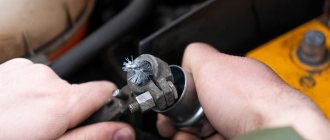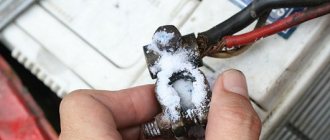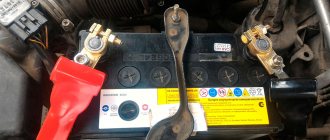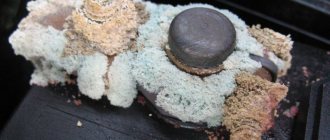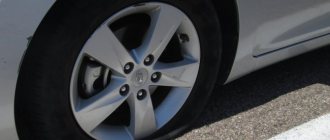If you use something correctly, it will last longer. Problems with new batteries are rare, especially if we are talking about a maintenance-free model. But sometimes it becomes necessary to remove the power source, for example, for recharging. The procedure is simple, but when connecting the battery back, it is important not to mix up the wires. In this article we will look at what happens if you mix up the battery terminals on a car.
If the battery is connected incorrectly, it may break and catch fire.
About battery terminal polarity
Batteries are produced with different characteristics, and the terminal locations also differ. A simple way to visually determine polarity:
- The battery is placed with the contacts facing you.
- With straight polarity, the “+” terminal will be on the left.
- With reverse “+” on the right.
Cars have different designs, which determine the principle of battery placement. In Asian cars (Hyundai, Kia, Daewoo, etc.) and VAZ models, the polarity is straight.
Straight polarity was invented back in the Soviet years, and on the Russian market it is usually designated as “1”. Reverse polarity is used in foreign cars (Ford and other "Americans"). In this case, the terminals can be placed not in the upper part of the housing, but on the sides.
Battery terminal polarity.
Consequences of incorrect battery connection
Let’s immediately dispel the myth that a battery connected “backwards” starts the engine in the opposite direction. Let's start with the starter: if the stator has a winding and not permanent magnets, then when the polarity is reversed, the direction of the current will change simultaneously in both the stator and the rotor, the starter will begin to rotate in the same direction as before. Think about the commutator motors of electric drills, grinders and other tools - they operate on alternating current, the direction of which is constantly changing.
A starter with permanent magnets on the stator will indeed begin to rotate in a different direction, but will not be able to crank the engine. Bendix will not allow force to be transferred in the “wrong” direction, that’s what it is designed for.
Even if you managed to spin the engine in the opposite direction, the four-stroke engine begins to take air from the exhaust manifold and throw exhaust gases into the intake manifold. So neither a carburetor nor an injection engine can be started this way, unless a diesel engine with a mechanical injection pump starts.
If the driver reverses the polarity of the battery during installation, then one of the most serious consequences will be that the generator will definitely suffer. Look at the diagram of its diode bridge (using the example of the simplest “Zhiguli” circuit):
A semiconductor diode is an element with one-way conductivity; it is not for nothing that its symbolic image looks like an arrow. It conducts current in the direction of this “arrow”, but not in the opposite direction. When the battery is connected correctly, then while the generator is not working (the voltage on its windings is less than the battery voltage), the diodes are locked - for the battery, the generator is a load that consumes several milliamps due to the presence of a small reverse current in the diodes.
If you mix up the terminals on the battery, the diodes in the bridge will open and the battery will be short-circuited through them. This will lead to overheating of the diode bridge and failure of the diodes with a characteristic odor and popping noise due to the destruction of their cases.
Burnt out generator diode bridge
But polarity reversal is not always harmful for on-board electronics. Any electronic device, if it was not assembled by Chinese children in labor lessons, has protection against polarity reversal. It is simply implemented using the same diodes: here they are open when connected “correctly”, and when connected “incorrectly” they cut off the load from the on-board network. However, diodes along the power supply circuit are rarely used in powerful current consumers - radio tape recorders and amplifiers. And they contain elements that are extremely vulnerable to polarity reversal - electrolytic capacitors, installed to smooth out voltage ripples precisely in the power circuits.
Electrolytic capacitors have a high specific capacitance and are therefore popular in electronics. But their weak point is that they work only at a certain polarity of the voltage on the plates; when the polarity is reversed, heating occurs, abundant gas evolution occurs (the capacitor swells), then an explosion. The larger the capacitance and dimensions of the capacitor, the stronger all this is - if a capacitor of a few microfarads clicks slightly, then the “cans” of thousands of microfarads used in amplifiers explode.
Failed capacitors
And a lot of relays in the wiring can make the same sound as the diodes in the alternator bridge. The fact is that in the windings of electromagnetic relays, when the voltage is turned off, a sharp surge of voltage occurs, which has reverse polarity relative to the power source. To eliminate the harmful effects of such pulses on the operation of sensitive electronics, it is customary to use diodes connected in the reverse direction. While voltage from the on-board network is applied to the winding, the diode is locked, and when the winding opens, it opens with an inductive surge pulse and extinguishes it. When the battery polarity is reversed, such diodes will burn out.
What happens if you mix up the terminals?
If the driver mixed up the battery terminals and nothing happened, which rarely happens, you must immediately remove the battery. The consequences of incorrect connection are different, and the most harmless is replacing the fuses.
Closure
It is difficult not to notice a short circuit due to the abundant sparking. And even an inexperienced driver will immediately realize that something is wrong. Assuming the battery works with electricity, as it should, melting wires and smoke will tell you otherwise.
For a driver faced with a short circuit, the first thing to do is to immediately disconnect at least one terminal.
Ignition, fire
If you leave an incorrectly connected battery for 10 minutes, there is a high risk of fire.
The most critical scenario. Sparks flying in all directions from under the hood will not lead to anything good. And if you leave the battery for 10 minutes during polarity reversal, there is a high probability of fire. Small electrical wiring begins to melt at a current strength of 55 - 60 A, and so not far from its braiding ignites. And there are also flammable technical fluids in the engine compartment. On average, a passenger car burns out in just 10 minutes.
You need to act quickly in such situations. If the battery was charged from a charger, pull out the plug. If an ignition does occur, the source of ignition is immediately extinguished.
Battery power drop
The design of a car battery has plates: some with positive polarity, others with negative polarity. Each one holds a charge and, if the terminals are connected incorrectly, a polarity reversal will occur - the “minuses” will tend to become “pluses”, and vice versa.
Due to the polarity reversal, the plates will begin to deform. And, if at least one is destroyed, part of the battery power will be lost. As a result, the capacity level will decrease, which in severe winter may not even be enough to start the car. And if the plates fall out, you can safely look for a new power source.
Damage to the electronic control unit
ECU board.
It happens that the driver connects the terminals incorrectly, and at first nothing happens. That is, the fuses do not react at all, which also happens. In such a situation, the ECU board, an important electronic component, will suffer - it will burn out. The on-board computer board, which is also called the “brains,” does not tolerate voltage surges, and if it fails, you will not be able to operate the car.
Fuse burnout
In terms of subsequent restoration costs, this is the most optimistic scenario. Fuse blocks are needed to protect consumers from increased current values.
If the driver reacted quickly and reconnected the battery correctly, it is still necessary to check the functionality of the electrical equipment - less powerful fuses could have blown, taking the brunt of the blow. If this is the case, and the car starts, it will be enough to replace the failed elements.
Generator failure
This part of the car is protected from failure by a diode bridge (if there is one). Due to a short circuit, it burns out, while the battery producing the current remains in working condition.
Problems with the generator will be indicated by an icon in the form of a battery that lights up on the dashboard. If the diode bridge burns out, no current will flow to the battery, that is, the generator will not be able to charge it.
Generator failure indicator.
As a rule, the generator does not change on its own, as this is a labor-intensive process. Usually the car is taken to a service station.
Alarm failure
Let us immediately note that standard protective equipment will not deteriorate, but third-party alarm systems may fail. Typically, special triggers are added to such devices that work with a specific connection scheme. And polarity reversal can disable them.
To restore your car's protection, you will have to contact the technician who installed the alarm.
Partial melting of wires
Due to a short circuit caused by incorrect connection of the terminals, not only the wires going to the battery can melt. The insulation of all wiring where there is an increased load will suffer.
Insulation failures can cause some vehicle systems to not function as intended. Due to power losses in the circuit, fuel consumption will increase, the brightness of the headlights will decrease, etc.
How to fix a breakdown - the wires are insulated with special tape. But this is only in emergency cases, for example, when the problem occurs on the road, and there is no way to properly diagnose the car. So, melted wires should be replaced with new ones.
Is it easy to get confused with connecting terminals?
In order not to accidentally get confused when connecting the terminals to the batteries, the negative terminal was made thinner than the positive one. That is, it will be very difficult to put the negative one on the positive contact, and the positive one cannot be simply attached to the negative contact. In addition, next to each contact there will be symbols “+” and “-”. Sometimes they are also distinguished in red and black (blue).
If the designations have been erased and it is impossible to determine where the “plus” and “minus” are, then there is no need to guess. To avoid confusion with the connection, it is recommended to use a tester or multimeter to determine the polarity of the battery. Even a severely discharged battery will be able to provide sufficient voltage to perform such a diagnosis.
Poor indoor lighting or work in the dark can also result in battery polarity reversal. Therefore, even if it is not possible to organize normal lighting, when connecting the battery, you can turn on the cell phone and accurately determine the polarity.
Note! The positive terminal is always thicker than the negative terminal and is indicated by a “+” sign; sometimes there is also a red casing on the contact.
Today I wanted to recharge the battery, I foolishly mixed up the terminals and plugged it into the outlet, I immediately realized that I had stepped on it and turned it off. Now I plug the charger into the socket, the charge current shows 0. What consequences might there be for the battery and charger?
Judging by your actions, nothing should happen to the battery. Charging - an autopsy will show. Maybe there are fuses there, then you'll have to change them
The battery is more likely alive than dead, the charger is more likely dead than alive.
probably a fuse on the charger
This has happened to me more than once. without consequences))) apparently the charge has come up, try someone else, get it from someone and check)))
The battery is definitely alive. because NOTHING would have happened to him during this time)))))
It depends on the charger. But in general, almost everyone has “Fool Protection”. No offense, that's just what it's called, look for the fuse and change it.
there was a case. The battery, discharged to 0, was attached to a home-made charger without properly checking the polarity. how long is it short? but the battery gained capacity and managed to reverse polarity. They put it on the Kruzak and that’s it. I’ll betray the kirdyk to the force and a lot of things.
I heard a similar story :) Interesting, it’s real.
It can not be so.
Absolutely real, I personally witnessed it in two cases, on a GAZ 53 and on a URAL motorcycle.
If this is normal industrial charging, then probably one of the fuses died
Maybe. I personally saw how the generator on a BMW was burned. By the way, the battery was also thrown out after that.
If charging is normal, there is at the output or before. or a diode in reverse connection, or this + that together.
What happens if you mix up the terminals when charging the battery?
If you notice the error in time and take appropriate measures, the consequences will be avoided. Otherwise, there is a high probability that the charger will burn out. If the battery has been severely discharged, it may “reverse polarity,” that is, the terminal pins will change polarity.
To return the polarity to normal, you need to completely discharge the battery, but slowly, for example, leaving the headlights on, and then charge it, having already connected the polarity properly.
It is recommended to give preference to chargers with a fuse - it will protect against burnout. Complete chargers have such protection, but many Chinese models do not, and it is better not to risk the performance of the battery.
The correct “lighting up” process
How to lubricate battery terminals to prevent them from oxidizing
Connection diagram for “lighting up”
Now let’s move on to considering the algorithm for how to properly “light” a car. The sequence of actions will be as follows:
- Before the procedure, the engine of the donor car should run for about 5 minutes at 2000...3000 rpm. This is done so that the battery is additionally recharged.
- Before “lighting up,” the engines, ignition, and all electrical appliances of both cars must be turned off! This is a mandatory requirement, which we will talk about with you later.
- Connect the ends of the “positive” wire first to the battery of the donor car (from which they “light”), and then to the recipient car.
- Connect the ends of the negative battery cable. First, to the negative of the donor car battery, and then to any metal surface that has been cleaned of paintwork (for example, an engine block) or to a protrusion on the car body. However, remember that when starting the engine, there is a possibility of a spark occurring at negative, which can hit the accumulation of oil and dirt, which in turn can cause a fire and even an explosion. Therefore, observe fire safety and “light up” outdoors or in a well-ventilated area. If you do not find a suitable protrusion, then connect the wire to the negative of the recipient battery. Be sure to observe polarity! One wire should connect two “pluses”, and the second - two “minuses”. If you reverse the polarity, a short circuit will occur and there is a high probability of failure of the entire electronics of the car. And this is fraught with expensive repairs!
- Sit on the steering wheel of the recipient car and try to start the engine. If the donor car's battery is in order, and you did everything correctly, then the engine will start without problems.
- Set the engine speed within 1500...2000 rpm, let it run for about 5 minutes so that the battery gains some capacity.
- Disconnect the wires from both batteries in the reverse order (that is, first disconnect them from the recipient and then from the donor, remove the negative wire first and then the positive one), pack them, close the hoods of the cars.
“Light up” the battery from a battery with the same voltage (for most cars it is 12 V, but for trucks it can be 24 V, for motorcycles - 6 V). Failure to comply with this rule will result in battery discharge and possible failure.
How to “light” a car correctly
If it was not possible to “light” the car within a few seconds, then you should not “torture” the battery. Try this:
- With the wires connected and the recipient engine and ignition off, start the donor engine.
- Let it run for about 10 minutes at 2000...3000 rpm. This will recharge both batteries.
- Turn off the engine, ignition and all electrical appliances of the donor. Try again to start the recipient's engine.
Typically, diesel cars have a larger battery capacity, so you can “light up” from them, but not all gasoline cars can give them their charge.
Thus, it is not at all difficult to “light” a car correctly from another battery. Now let's look at some common myths and useful tips.
What happens if you mix up the terminals when lighting a cigarette?
The procedure for disconnecting the wires when lighting a cigarette.
If the wires are connected incorrectly, a short circuit will occur. And if they are of poor quality and thin, they will simply burn out. The higher the cross-section, the lower the likelihood of burnout, but the wires will start to heat up, and this will lead to other consequences.
“Plus” is connected first, then “minus”. After “lighting up”, the order of disconnecting the wires is as follows: first “minus”, then “plus”.
“Lighting up” is an extreme measure, as it loads the on-board network.
Having mixed up the battery terminals, the first thing you need to do is reset them, and then you can avoid more serious consequences. The price of a mistake can be the car itself, and the driver must remain vigilant.
Short circuits in the network
What happens if you short the battery terminals? Given the ability of starter batteries to briefly deliver current of hundreds of amperes, an object that shorts the terminals (for example, a wrench accidentally caught between the “plus” and the car body) will melt. More massive metal objects can become tightly welded to the terminals or body, causing the battery to go “zero.” At risk are cars where the battery is installed in the trunk - you should not carelessly throw keys or towing lugs there, it is unknown where they will end up under the influence of shaking while driving.
Battery short circuit when hit by a foreign object
Since such short circuits occur hidden from the owner (a key accidentally dropped during repairs can at least be immediately seen), they are the most dangerous - there is a high probability of ignition in the trunk.
Determination of magnitude
To be able to accurately determine the type of polarity at a glance, it is enough to pay attention to one of the two opposite signs. https://www.youtube.com/embed/8NDkZECcNvM
When marking batteries, special numbers are used. For example:
- Straight polarity of the battery is marked with the number “1”. Such batteries are installed in domestically produced cars. Today the Lada Priora is equipped with them.
- Reverse battery polarity. Marked with the number “0”. It is usually present in batteries of foreign-made cars. Of course, this arrangement also occurs on our cars, but it happens very rarely.
You can easily make a mistake when purchasing and purchase the wrong battery that you need: for example, buy a battery with direct polarity when reverse polarity is required.
It’s good if the buyer is able to determine this indicator himself: then he will just need to look at the product and choose the one he needs. If a car enthusiast who comes to the store is not aware of what it is and how it is determined, he should turn to the seller for help, who will definitely tell him. To do this, just tell him your model.
How to determine the polarity of a battery and the dangers of confusing the polarity
Let's look at how to determine what type of polarity a battery has. And here everything is simple, you just need to turn the battery “facing” towards you. You can navigate by the label on the side surface, since it is glued to the front part, or by the terminals themselves. The battery needs to be rotated so that they are located on the near side, that is, facing you. And after that you need to look at which side the conclusions are located. If the “positive” is on the left, then this is direct polarity, if on the right, it is reverse.
And now about the dangers of making the wrong choice of polarity, and what problems this can create. The polarity is indicated for a reason. The fact is that each car has a special seat for the battery, where it is secured. In this case, the wires from the on-board network are supplied from each side and their length is a certain one. All this is aimed at ensuring that you do not accidentally confuse them before connecting. But it is still possible to connect the battery incorrectly due to the same polarity
For example, a VAZ has a straight polarity battery installed, but the owner did not pay attention when buying a new one and bought a “European” battery. When trying to install it on a car, the “plus” turns out to be on the other side, so you end up with a “reversal”, which can cause significant harm
Let's say right away that battery manufacturers also take part in preventing possible incorrect connections. And they do this by using pins of different sizes. The diameter of the “positive” terminal is larger than the “negative” one. The terminals that connect to the wires also differ in the size of the holes. Therefore, it will not be possible to attach and secure, for example, the “negative” terminal to the “positive” terminal (unless you use a hammer). Additionally, manufacturers apply embossing on the body indicating which terminal it is.
Something else useful for you:
- What happens if you mix up the terminals and connect the battery incorrectly?
- Why did the battery light on the instrument panel come on?
- What is the density of the electrolyte in the battery - what should it be, check, how to increase
Battery device
A classic “12V” car battery is six “2V” lead-acid batteries connected in series in one circuit to produce the required voltage, capacity and power (starting currents). Each can consists of a stack of metal plates that alternate positive and negative charges. The lead dioxide anode is responsible for the plus, and the lead cathode is responsible for the minus. The catalyst for the electrochemical reaction is an aqueous solution of sulfuric acid (electrolyte), which can be liquid, absorbed into fiberglass, or gel-like.
When a load is connected to the battery (discharge operating mode), electrons from the cathodes move to the anode, creating output electricity and reducing the density of the electrolyte. When the capacity is replenished (charge from a generator or charger), reverse processes occur. In this case, various options for packaging packages in cans and methods for connecting plates of the same charge with a solid bridge-conductor are possible. As a result, the terminal down conductor with the “+” or “-” sign can be located either at the beginning of the housing or at the end.
Stories of car owners.
“Recently, in a hurry at home, I got confused with the wires while charging, indeed, everything was fine with the battery, but the charger had to be replaced: there was some kind of cheap charger, there was no fuse in it, so it burned out completely, but the main thing is that the battery is fine.”
“I don’t know how you can wait 1-2 minutes when lighting a cigarette, as soon as I touched the second terminal on the donor car, it sparkled so much that the thought of completing the connection did not even arise, they quickly turned everything off and reset it, only then did they realize that there was something wrong with the polarity got it wrong."
“Fuses are always the first thing to look at, not only when everything seems fine, but also when the car won’t start. They are the first thing that flies when the terminals are confused.”
“I was always surprised how people can mess up terminals, but last week I encountered this myself - I installed the battery late in the evening, when it was already dark, and so I got it wrong. As a result, the car stopped starting, although the starter clicked. I went through all the fuses, everything is fine, checked the generator and so on, in general, it turned out that the battery simply died... although the headlights turned on, it was clear that the power had dropped significantly.”
